The Marine Communication Market is estimated to be valued at USD 54.7 billion in 2025 and is projected to reach USD 117.0 billion by 2035, registering a compound annual growth rate (CAGR) of 7.9% over the forecast period.
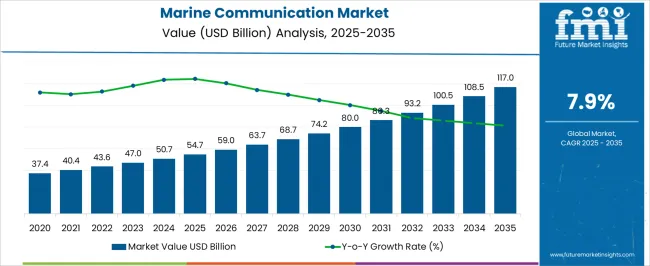
| Metric | Value |
|---|---|
| Marine Communication Market Estimated Value in (2025 E) | USD 54.7 billion |
| Marine Communication Market Forecast Value in (2035 F) | USD 117.0 billion |
| Forecast CAGR (2025 to 2035) | 7.9% |
The marine communication market is expanding steadily as maritime operators prioritize safety, regulatory compliance, and efficient navigation across global waters. Rising international trade volumes, increased offshore exploration, and growing passenger traffic in commercial shipping are reinforcing the demand for reliable communication systems.
Adoption of advanced digital technologies, integration of satellite networks, and regulatory mandates from international maritime authorities are further shaping industry growth. Investment in cybersecurity and real time vessel tracking solutions is becoming a key priority, ensuring secure and uninterrupted communication across fleets.
The market outlook remains positive as the shift toward connected vessels and smart marine ecosystems continues to accelerate, offering opportunities for innovation in digital platforms and service integration.
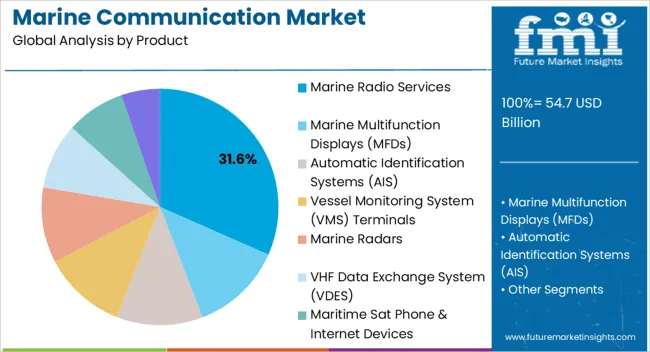
The marine radio services segment is projected to account for 31.60% of total market revenue by 2025 within the product category, positioning it as the leading product segment. Growth in this area is being driven by mandatory compliance requirements for vessel safety, enhanced reliance on radio systems for navigation, and demand for dependable communication in both coastal and deep sea environments.
The ability of marine radios to operate effectively in challenging weather conditions and provide distress alerting has further strengthened their adoption across commercial and defense fleets.
Continuous advancements in digital and satellite supported marine radios are also supporting this growth, making marine radio services the preferred product choice in maritime communication.
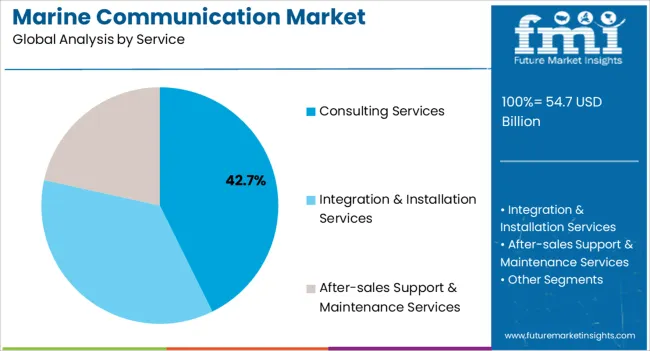
Consulting services are expected to contribute 42.70% of total market revenue by 2025, making them the most dominant category within services. This growth is being driven by the need for expert guidance in implementing advanced communication infrastructure, ensuring regulatory compliance, and managing operational complexities across diverse maritime environments.
Service providers are increasingly being engaged to assist with system integration, risk management, and optimization of digital platforms. The reliance on consulting services is further supported by the rapid pace of technology adoption and the complexity of integrating traditional marine communication systems with modern satellite and digital networks.
This has reinforced consulting services as the leading revenue contributor within the service segment.
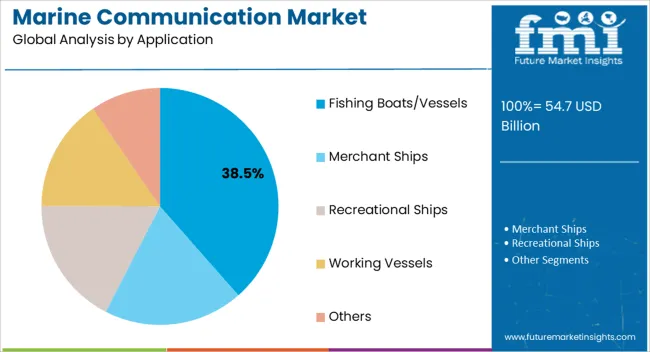
The fishing boats and vessels segment is projected to hold 38.50% of total market revenue by 2025 within the application category, making it the leading segment. This growth is supported by the rising need for communication systems that enhance crew safety, enable efficient navigation, and ensure compliance with fishing regulations.
The adoption of marine communication solutions in fishing fleets has been further strengthened by regulatory measures that require distress alerting and location tracking capabilities. Additionally, the growing commercial importance of sustainable fishing and offshore operations has prompted wider use of advanced communication equipment in fishing vessels.
As these vessels often operate in remote and challenging maritime conditions, reliable communication technologies remain indispensable, establishing this segment as the largest contributor within applications.
In 2020, the global marine communication market size stood at USD 3,251.5 million. From 2020 to 2025, the market experienced substantial development amplification, accounting for USD 4,420.7 million in 2025. The marine communication market expanded at a considerable CAGR of 5.8% from 2020 to 2025.
Satellite communication plays a critical role in managing the integration of modern satellite communication into existing communications and reconnaissance architectures. The development of satellite communication infrastructure helps in providing new terrestrial communication networks to increase operational agility.
Various technology vendors are developing advanced satellite systems to reduce the time gaps and cover more geographical locations. For instance, Inmarsat a global satellite communication provider, offers a geostationary system that has four operational satellites. One each is mounted over the Pacific and Indian Oceans and a further two cover the Atlantic Ocean for faster and reliable land and marine communication.
The VHF-based Data Exchange System (VDES) provides a robust and globally standard communication system for e-navigation. It supports the safety and efficiency of ship and shore operations. The reduced cost of deployment and improved communication is creating demand in various countries around the globe.
Moreover, marine electronic vendors are also focusing on offering cost-effective satellite-based communication. For instance, EGNOS, a European Satellite-Based Augmentation Service (SBAS), corrects GPS signals to increase the accuracy of position information. Thus, the demand for satellite-based communication systems is driving the demand and is fueling the global marine communication market.
Maritime Satellite Developments to Drive Sat Phones and Internet Devices Demand
The Maritime sat phones and internet devices are expected to show significant growth in the coming years. This is attributable to the increasing maritime satellite developments and adoption of new-generation broadband satellite services. Globalization has opened the doors for trade across the world and it has thus become necessary for ships to be equipped with the latest forms of communication and technology.
Maintaining strong communication is perhaps the most important part of ensuring the safety of vessels in the maritime industry. To ensure the smooth facilitation of trade and other services, all the ships and vessels on the water need to maintain proper maritime communication.
Satellite communication enables the crew onboard ships to be able to connect with other ships and teams to keep them updated with the current situations on-board in real-time, which helps reduce errors and thereby increase efficiency.
Marine radio services are predicted to garner swift growth during the forecast period. In 2025, the marine radio devices segment captured a 25.1% market share. Marine radio devices can operate over long distances using Very High Frequency (VHF) or High Frequency (HF) bands.
They can provide reliable communication in different maritime environments, overcoming rough weather, interferences, and others. This reliability makes marine radio devices indispensable for maintaining effective communication in adverse conditions and remote areas.
Integration of Advanced Technologies Improving Scope for Marine Communication Application in Recreational Vessels
Based on application, the marine communication market is segmented as fishing boats/vessels, merchant ships, recreational vessels, working vessels, and others. The recreational vessels application segment is set to witness a relatively higher CAGR during the forecast period. The merchant ships segment accounted for a large market share in 2025. New technologies are continuously getting developed related to communication and navigation.
The integration of IT in communication has paved the way for the usage of electronic devices in several applications, thereby greatly enhancing its utility. For instance, the use of big data analytics on AIS helps vessels and shipping companies to predict and detect anti-national activities with the support of domain awareness and maritime intelligence.
Demand for Satellite Communication Technology to Grow in the Shipping Sector
Merchant shipping is mainly used for carrying passengers or cargo for commercial purposes. To stay updated with the changing communication trends, shipping companies are accordingly designing and manufacturing ships and passenger vessels to ensure crew and passenger loyalty and satisfaction.
In recent years, satellite communication technology has been adopted by several shipping companies for the development of advanced ships and vessels. This technological advancement helps merchants gain higher profit through reliable communication services that maintain operational efficiency.
Integration & Installation Services to Register Swift Growth During the Forecast Period
The integration & installation services in marine communication are expected to witness unparalleled growth during the forecast period. In 2025, the integration & installation services registered a 44.8% market share. The developments in marine communication systems have increased manifold in recent years. Integration of satellite-based technologies, advanced navigation systems, and broadband connectivity has become complex.
These sophisticated systems require expertise and specialized knowledge for proper integration and installation. Ensuring seamless marine communication requires integrating these systems. Due to the growing maritime operations, the integration & installation segment is likely to flourish in the coming years.
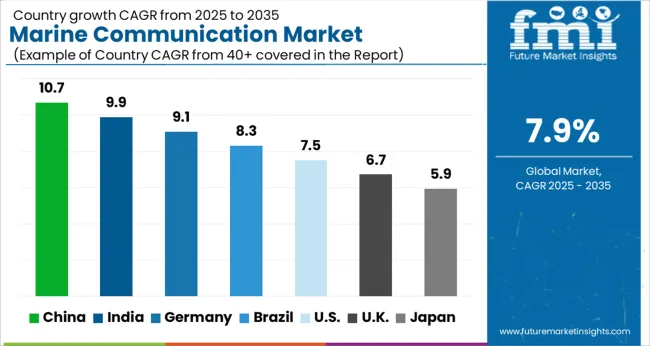
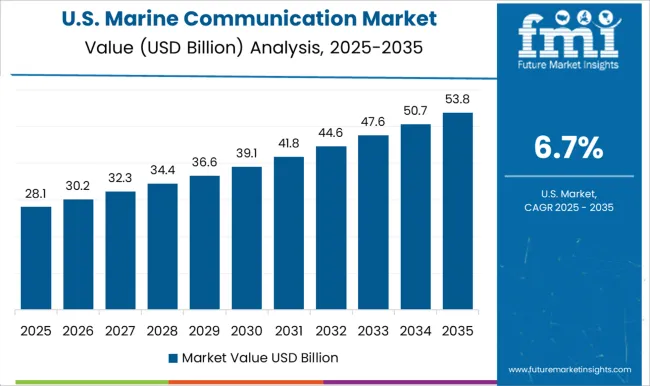
United States to Remain Dominant Market in North America
In 2025, the United States captured 16.4% shares in the global marine communication market. The United States marine communication market is set to aggrandize at a high CAGR through 2035. FMI has projected the United States to remain a lucrative market in North America through the course of the forecast period, owing to continuous developments in satellite-based communication systems.
According to estimates, marine communication shipment in the United States is increased by 4% due to a rise in maritime tourism and an increase in United States seaborne trade. Moreover, increasing demand for enriched content from seafarers, crew, and passengers has caused a key spike in the growth of the United States marine communication market. Besides this, the demand from oil and gas vessels, merchant shipping, mining ships, and passenger shipping sectors has propelled the growth.
Government Initiatives Favoring Growth in the United Kingdom
The United Kingdom has strong international standing as a center for design, engineering, marine equipment, and research, coupled with its position as the world’s leading maritime financial, professional, and business services hub. Also, the United Kingdom has a geographical comparative advantage when it comes to Arctic shipping.
In coming years, the United Kingdom is expected to see an increase in demand for maritime communication systems and infrastructure, from the development of remotely operated vessels to the need for increased satellite coverage of remote areas like the Arctic. The government of the United Kingdom and the maritime communication tech players are collaborating to develop advanced communication systems for shipping and autonomous vessels.
The growing demand for marine communication products from shipping companies is driving the growth of the United Kingdom marine communication market. The marine communication market registered a 12.4% market share in 2025.
Telecommunication Satellites Launched in China Driving Marine Communication Demand
China is estimated to record an incremental opportunity worth more than USD 54.7.0 million during the forecast period. In 2025, China registered a 14.2% market share globally. China’s government is continuously focusing on the development of advanced satellite communication systems to ensure secure and reliable communication in land and maritime industries.
For instance, in July 2024, China successfully launched its APSTAR-6D telecommunication satellite. The satellite can be used for maritime communications, aviation airborne communications, land vehicle communications, and fixed satellite broadband Internet access. Moreover, the South China Sea is a prominent shipping passage with USD 5.3 trillion worth of trade cruising through its waters every year. That’s nearly one-third of all global maritime trade.
As the second-leading economy in the world with over 60 percent of its trade-in value traveling by sea. China’s economic security is closely tied to the South China Sea. Thus, to enhance communication in marine tread activities, China government is continuously focusing on investing in the construction of new marine communications systems and infrastructure, which in return, may drive the growth of China's marine communication systems market.
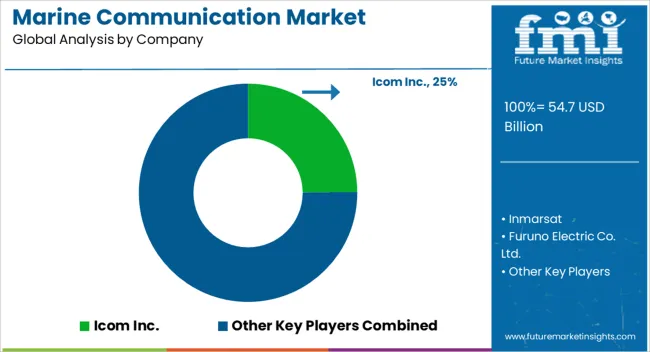
Key Players Launch New Products to Capture Growth
The key players rely on multiple expansion strategies to deepen penetration across lucrative markets. These strategies include product launches, collaborations with key players, partnerships, acquisitions, and strengthening of regional and global distribution networks.
Recent Developments Observed by FMI:
| Attribute | Details |
|---|---|
| Forecast Period | 2025 to 2035 |
| Historical Data Available for | 2020 to 2025 |
| Market Analysis | USD million for Value |
| Key Regions Covered | North America; Latin America; Europe; East Asia; South Asia & Pacific; The Middle East & Africa (MEA) |
| Key Countries Covered | United States, Canada, Germany, United Kingdom, Nordic, Russia, BENELUX, Poland, France, Spain, Italy, Czech Republic, Hungary, Rest of EMEAI, Brazil, Peru, Argentina, Mexico, South Africa, Northern Africa, GCC Countries, China, Japan, South Korea, India, ASEAN, Thailand, Malaysia, Indonesia, Australia, New Zealand |
| Key Segments Covered | Product, Service, Application, Region |
| Report Coverage | Market Forecast, Company Share Analysis, Competition Intelligence, Trend Analysis, Market Dynamics and Challenges, and Strategic Growth Initiatives |
The global marine communication market is estimated to be valued at USD 54.7 billion in 2025.
The market size for the marine communication market is projected to reach USD 117.0 billion by 2035.
The marine communication market is expected to grow at a 7.9% CAGR between 2025 and 2035.
The key product types in marine communication market are marine radio services, _fixed-mount vhf marine radios, _handheld marine vhf radios, _mf/hf radios, marine multifunction displays (mfds), automatic identification systems (ais), _ais transponders, _ais receivers, vessel monitoring system (vms) terminals, marine radars, vhf data exchange system (vdes), maritime sat phone & internet devices and others.
In terms of service, consulting services segment to command 42.7% share in the marine communication market in 2025.






Full Research Suite comprises of:
Market outlook & trends analysis
Interviews & case studies
Strategic recommendations
Vendor profiles & capabilities analysis
5-year forecasts
8 regions and 60+ country-level data splits
Market segment data splits
12 months of continuous data updates
DELIVERED AS:
PDF EXCEL ONLINE
The Submarine Communication Cable Industry Analysis in the Mediterranean is segmented by cable type, installation, application and country from 2025 to 2035.
Submarine Communication Cables Market Trends – Demand & Forecast through 2034
Marine Life Raft Market Size and Share Forecast Outlook 2025 to 2035
Marine Trenchers Market Size and Share Forecast Outlook 2025 to 2035
Marine Electronics Tester Market Size and Share Forecast Outlook 2025 to 2035
Marine Steering Systems Market Size and Share Forecast Outlook 2025 to 2035
Marine & Dock Gangways Market Size and Share Forecast Outlook 2025 to 2035
Marine HVAC System Market Size and Share Forecast Outlook 2025 to 2035
Marine Outboard Engines Market Size and Share Forecast Outlook 2025 to 2035
Marine Stabilizers Market Size and Share Forecast Outlook 2025 to 2035
Marine Fuel Injection System Market Size and Share Forecast Outlook 2025 to 2035
Marine Energy Market Size and Share Forecast Outlook 2025 to 2035
Marine Propulsion Engine Market Size and Share Forecast Outlook 2025 to 2035
Marine Protein Hydrolysate Market Size and Share Forecast Outlook 2025 to 2035
Marine Fin Stabilizer Market Size and Share Forecast Outlook 2025 to 2035
Marine Extract Market Size and Share Forecast Outlook 2025 to 2035
Marine Squalene Alternatives Market Size and Share Forecast Outlook 2025 to 2035
Marine Prebiotics Market Size and Share Forecast Outlook 2025 to 2035
Marine Collagen-Based Products Market Analysis - Size, Share, and Forecast Outlook 2025 to 2035
Marine Derived Proteins Market Size and Share Forecast Outlook 2025 to 2035

Thank you!
You will receive an email from our Business Development Manager. Please be sure to check your SPAM/JUNK folder too.
Chat With
MaRIA